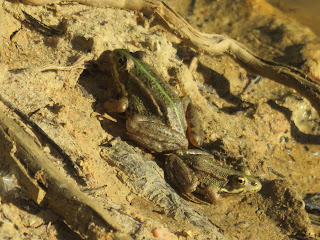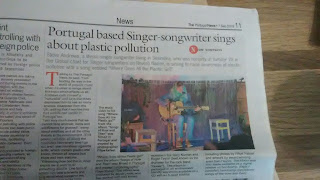Ribeira do Marchante is a vanishing river
There is a river in Quinta do Conde in Portugal known as the Ribeira do Marchante or the Ribeira de Coina. It was once a navigable river that had a lot of water and even supported rice fields back in the 1800s. Today it can be difficult to see, and difficult to find any stretches of water that are not choked with Giant Reeds (Arundo donax) and other vegetation.
In the droughts that are now a new normal in Portugal due to Climate Change, the bed of this river is often dry for much of its course, and for much of the year. Rubbish and fly-tipping litter its banks and surrounding areas.
Some of this trash is in the river itself. This river is disappearing. The land next to it has many Eucalyptus trees. They are known to take a lot of groundwater from any land they are growing in. This non-endemic tree is adding to the threats to the river’s health. I have lived in Quinta do Conde for eight years and have seen the Ribeira do Marchante in much better condition in the first years I was here. In the past I have seen ducks swimming on it, Iberian Water Frogs (Pelophylax perezi)
in many parts, and I have even seen a rare European Pond Tortoise (Emys orbicularis) dive into the water. On World Rivers Day (24 September), with the EcoGrupo Trevo, local environmental conservation group, I went walking the route of the Ribeira do Marchante, including a part that I was not familiar with. I was horrified to see how much Giant Reed is now growing in and along the river. If it continues like this there will be no water flowing. The Giant Reed is an invasive species and creates problems in many parts of the world. It is resistant to fires because it can regenerate, it uses up a lot of water, its roots go deep into the soil making it hard to remove, it spreads rapidly, it grows very quickly, and it displaces native vegetation while destroying wildlife habitat. As for the Eucalyptus trees, several years ago a team of men cut down some of the trees near the Sports Stadium, which is close to the river. However, they left the stumps and soon after the trees sprouted again.
The Eucalyptus recovers quickly when felled, and also regenerates after being burned in wildfires. This tree is causing a big problem in many parts of Portugal. In addition to all this, paths through the woodland on the banks of the river are being churned up by trail bike riders, people on 4-wheelers, and we even encountered a car actually driving along the riverbed in one part. All of this causes sand to wash down into the river in storms. My conclusion is that the Ribeira do Marchante needs help, and needs help urgently or it will continue to decline fast and will eventually be no more than a memory. I am a member of ESRAG (Environmental Sustainability Rotary Action Group) and this group is very concerned with restoration of rivers and wetland. There is an Adopt a River group. I am also an active member in SAVE THE FROGS! a charitable organisation that, as its name suggests, is dedicated to saving frogs and other amphibians worldwide. There are grants available from Rotary and from SAVE THE FROGS to fund the sort of work that would be needed to save the Ribeira do Marchante. I am hoping that the money can be found to fund a restoration project. I think something should be done to halt the destruction of this river before it is too late.
Portuguese:
A Ribeira do Marchante é um rio em extinção
Existe um rio na Quinta do Conde em Portugal conhecido como Ribeira do Marchante ou Ribeira de Coina. Já foi um rio navegável que tinha muita água e até sustentava campos de arroz no século XIX. Hoje pode ser difícil ver e encontrar trechos de água que não estejam obstruídos por Canas/Juncos gigantes (Arundo donax) e outras vegetações. Nas secas que são agora uma nova normalidade em Portugal devido às Alterações Climáticas, o leito deste rio fica frequentemente seco durante grande parte do seu curso e durante grande parte do ano. Lixo e despejos espalhados pelas margens e áreas adjacentes. Parte desse lixo está no próprio rio. Este rio está desaparecendo. O terreno ao lado possui muitos eucaliptos. Sabe-se que retiram muita água subterrânea de qualquer terreno onde crescem. Esta árvore não endémica está a aumentar as ameaças à saúde do rio. Moro na Quinta do Conde há oito anos e vi a Ribeira do Marchante em muito melhores condições nos primeiros anos que aqui estive. No passado, vi patos nadando nele, rãs d'água ibéricas (Pelophylax perezi) em muitas partes, e até vi uma rara tartaruga europeia (Emys orbicularis) mergulhar na água.
No Dia Mundial dos Rios (24 de Setembro), com o EcoGrupo Trevo, grupo local de conservação ambiental, fui percorrer o percurso da Ribeira do Marchante, incluindo uma parte que não conhecia. Fiquei horrorizado ao ver quanto Cana está crescendo agora dentro e ao longo do rio. Se continuar assim não haverá água fluindo. A Cana é uma espécie invasora e cria problemas em muitas partes do mundo. É resistente ao fogo porque pode se regenerar, consome muita água, suas raízes penetram profundamente no solo dificultando sua remoção, se espalha rapidamente, cresce muito rapidamente e desloca a vegetação nativa ao mesmo tempo que destrói o habitat da vida selvagem. Quanto aos eucaliptos, há vários anos uma equipa de homens derrubou algumas árvores perto do Estádio Desportivo, que fica perto do rio. Porém, eles abandonaram os tocos e logo depois as árvores voltaram a brotar. O eucalipto se recupera rapidamente quando derrubado, e também se regenera após ser queimado em incêndios florestais. Esta árvore está a causar um grande problema em muitas zonas de Portugal.Além de tudo isso, os caminhos pela mata às margens do rio estão sendo agitados por ciclistas de trilha, pessoas em veículos de quatro rodas, e até encontramos um carro passando pelo leito do rio em um trecho. Tudo isso faz com que a areia desça para o rio durante as tempestades. A minha conclusão é que a Ribeira do Marchante precisa de ajuda, e precisa de ajuda urgentemente ou continuará a diminuir rapidamente e acabará por não passar de uma memória.Sou membro do ESRAG (Grupo de Ação Rotary para Sustentabilidade Ambiental) e este grupo está muito preocupado com a restauração de rios e zonas húmidas. Existe um grupo Adote um Rio.
Também sou um membro ativo do SAVE THE FROGS! uma organização de caridade que, como o próprio nome sugere, se dedica a salvar sapos e outros anfíbios em todo o mundo. Existem subsídios disponíveis do Rotary e da SAVE THE FROGS para financiar o tipo de trabalho que seria necessário para salvar a Ribeira do Marchante. Espero que o dinheiro possa ser encontrado para financiar um projeto de restauração. Penso que algo deveria ser feito para impedir a destruição deste rio antes que seja tarde demais.








































